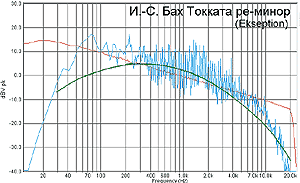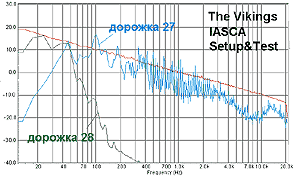
Popularized by the performance of the Toccata. Midbass is more of Abbasov - less, and with the upper frequencies - the story is quite sad.
But at the end of those 60's was a band from the Netherlands called Ekseption. (That's not a typo, is spelled that way.) They were the first, or nearly first, began to popularize classical music, combining Philharmonic with modern tools for 60s. Toccata in d minor by J. S. Bach, arranged by R. van den Linden) has always been the hallmark of Ekseption. The range of their business cards on the left.
It's funny that on the nature of the spectrogram to a greater extent affected by the signs of progress in the recording of the last 30 years, rather than the promotion of execution. Spectrum at lower frequencies is more "understandable" than the classic version, easy to read simple equipment midbass is complete, and serious low - not even very. But at higher frequencies, despite the fact that the score of Bach generous hand of Herr van den Linden were added impact, energy is much more modest than what is currently being recorded. And as we were Somali from lindenbusch plates, it seemed much wider than the strip of recording does not happen. As it turned out, that's what, above 10 kHz tears, and only. There's nothing older.
But back to bass, it's the Dutch and the nostalgia was distracted by common efforts. So, the first conclusion that we have the right to do: real music essential components of the signal below 30 - 40 Hz almost never contains. And if so, and characteristics of the subwoofer should be optimized for the real signal, not a mathematical abstraction.
In this regard, in a somewhat new light appears as a common device for lifting bass amplifiers - bass boost, which is almost always tuned to frequencies between 40 and 45 Hz. At first glance, the device is not of Royal blood, like - for swotting, at the expense of musicality. Now, let's see with an open mind: the rise of frequencies 40 Hz means of their (relative) attenuation at frequencies below 40, 30 and so on. So, if you arrange the frequency response of the subwoofer with a reasonable decline to 40 Hz, and then lift the AFC at this point, there is a chance to obtain the frequency response is optimized in relation to the spectrum of a real music signal.
In the light of real musical spectrum common device bass boost starts to look different...
Than a poor frequency response of the subwoofer with overly broad bandwidth? Yes is this: very often (including in the tests we have) you can see the frequency response of the subwoofer, stretching to the bottom, deep infrasound frequencies, not just without decay amplitude, and rise. This is often the case, for example, when installed in free air. As a consequence, this subwoofer will not play God knows how on the actual bass frequencies (above 35 Hz). But will start inappropriate to try at frequencies below 30 Hz, where the music is already there, and the opportunity to hang out with a large amplitude, giving rise to distortion.
But then the very notion of "subwoofer"? After all, as the name implies, "subwoofer" - a part of the acoustic system designed to reproduce low and ultra-low (Abbasova) frequencies. Does anyone in this world? Let's check it.
This sporting life
To compete in car audio capabilities audio on the part Abbasova frequencies are measured by the same standard with a soundtrack judicial disk IASCA Competition. This is a recording of works called "The Vikings", performed at the music center name of Morton Myerson in Dallas, the state of, you know, Texas. Monstrous size (as reported in the accompanying leaflet) playing in a very large room, produces a magnificent sounds. Range, reflecting the greatness bottom left.
No doubt, here Abbasova frequency - in abundance. The amplitude of the signal, even at 10 Hz is more than substantial. The system is capable of not straining to win back what is recorded on this track judicial disk worth of prizes and awards. But look at all this is a practical eye. Moreover, the drafters of the disk to us for yourself helped. On the setup disc Setup&Test recorded in the laboratory Sheffield also commissioned IASCA, there are two more options "Viking". One of them, the original recording was subjected to the procedure of "circumcision" low pass filter of the sixth order with a cutoff frequency of 50 Hz. The result - on the track 27 of the disk IASCA Setup&Test. On the next track that is withdrawn from the original soundtrack as a result of painful procedure.

"The Vikings": the reference entry for the evaluation of Abbasov at competitions all over the world.

Entry "Viking", specially treated for disk Setup&Test.
The listener is asked to assess how much the sound of his system intact when playing on the soundtrack contains the whole range of frequencies, and "circumcised." Typically, the difference is audible. In many cases (not all, but a large number) filtered record sounds better. But winning those who have unfiltered sounds better, because it contains the judgment disk.
Many great sounding audio system does not reproduce what is written on the referee IASCA disc. However, it is not recorded anywhere else. Or almost anywhere...
But now look: filtered soundtrack by its spectral composition is surprisingly close to the spectrum of "normal" (typical, expected, call it what you will) record. It turns out that the requirements for the "sport" setting to normal and, to put it mildly, not exactly the same. On the one hand, it is justified: judicial record places high demands on the system, as expected at the event. On the other hand, many great-sounding audio system in this competition will lose, because not reproduce what is written on the referee disk and not recorded anywhere else. Or almost anywhere else. Now about that "almost".
Literature
- The Magazine "Car Audio" No. 11 / 2000
Author: Andrew Elyutin; Publication: www.avtozvuk.com, www.cxem.net






